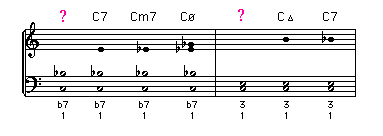(Down - Up - Top - Links)
JT 19.2 - Skeleton Chords
The 3rd and 7th are also the essential notes to form a skeleton chord (a chord in which one or more chord tones are missing).
The two notes can form a skeleton chord by themselves, or an additional note is added. Such as the root, the 5th, the 9th or the 13th.
Audio 2

When a skeleton chord contains only one of the two essential chord tones the chord quality becomes ambiguous.
To define the chord quality the missing tone (3rd or 7th) must be played in the melody or the improvisation (in the right hand for keyboard players).
Audio 3

(Down - Up - Top - Links)
JT 19.3 - Chord Plurality
Through previous lessons it has become clear that a scale (or mode) and the scale-tone chord built on the tonic of that scale are closely related.
They are in fact two different expressions of the same tonality.
The scale is a horizontal expression, the chord a vertical expression of that tonality.
The complete chord contains, like the scale, all the notes that constitute the tonality.
Here an example of the tonality of the C Lydian mode :
- the horizontal expression of the tonality is the 7-note C Lydian mode.
- the vertical expression of the tonality is the 7-note Cmaj13#11 chord.
Audio 4

|
As shown above any chord can be extended upwards by stacking alternate notes of the related scale on top of the chord. It is important to understand that these additional notes do not alter the chord quality but merely add more colour to the chord.
The quality of the chord, once set by the essential chord tones (3 and 7), remains the same! This means that keyboard players and guitarists can always substitute 7th chords by their equivalent 9th, 11th or 13th chords. |
Within the complete chord a variety of smaller chords with different roots are present.
Audio 5

This is called plurality.
For the three important chord qualities the complete 7-note chords are :
Audio 6

To achieve a better, more open (Lydian) sound the 11th is always sharpened in the major chord and most of the time in the dominant chord.
To construct chords that extend beyond the 9th use therefore these scales :
- major chords : the Lydian mode = 1 2 3 #4 5 6 7
- dominant chords : the Lydian Dominant scale = 1 2 3 #4 5 6 b7 (see Lesson 20)
- minor chords : the Dorian mode =1 2 b3 4 5 6 b7
Modern chord voicings and chord substitutions use pluralities built on the chord's 3rd.
This means that the root is omitted, but both essential tones, the 3 and 7, are present in the chord.
Omitting the chord root gives the music a less predictable and contemporary quality.
The root of the chord (C in the example below) is either played by another instrument (e.g. the bass in a small Jazz ensemble), or inferred by the melody or improvisation in the right hand.
Note the switch in chord quality :
- the E minor 7th chord for example is perceived as C major 9th, and
- the Eb major 7th chord becomes C minor 9th